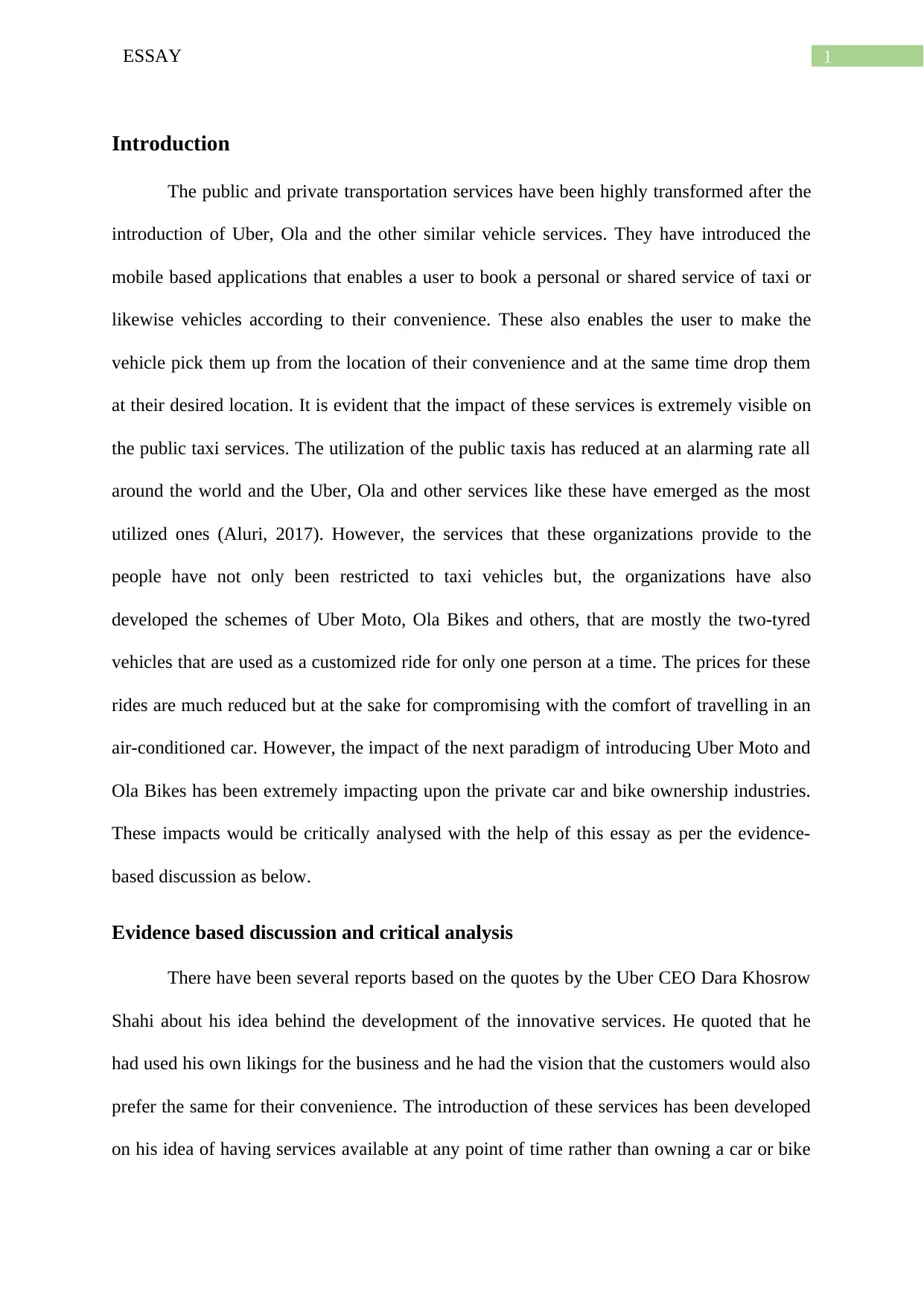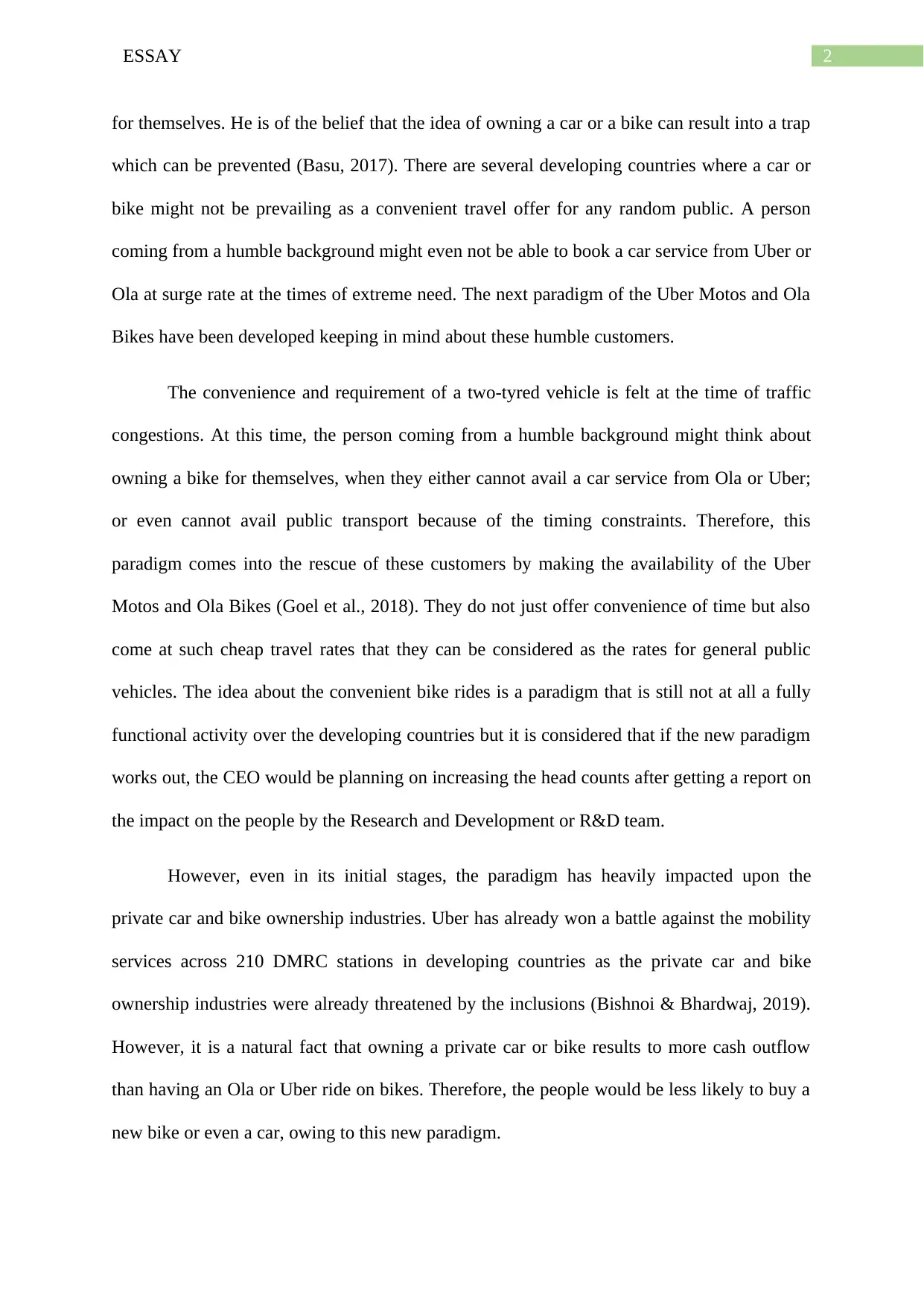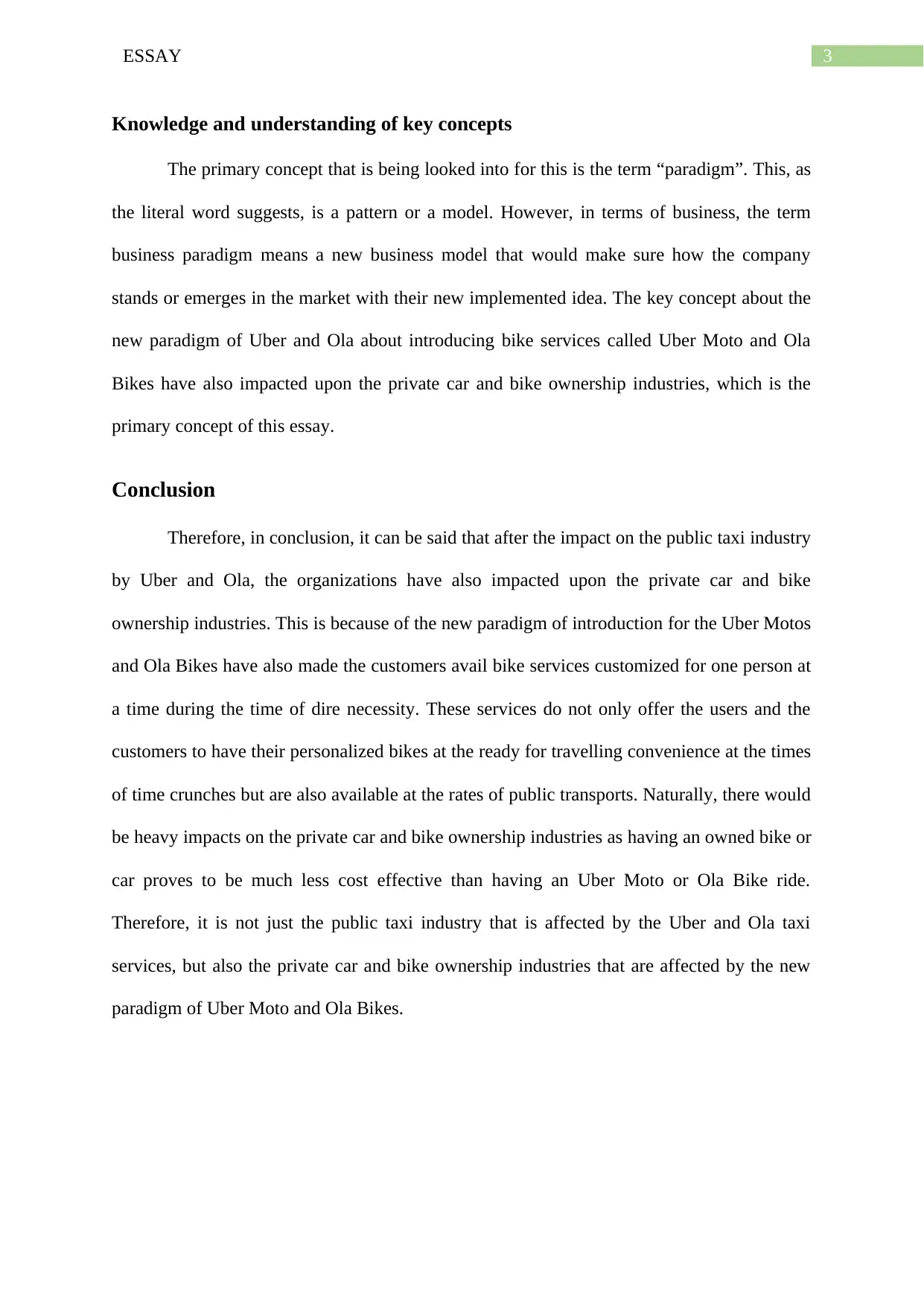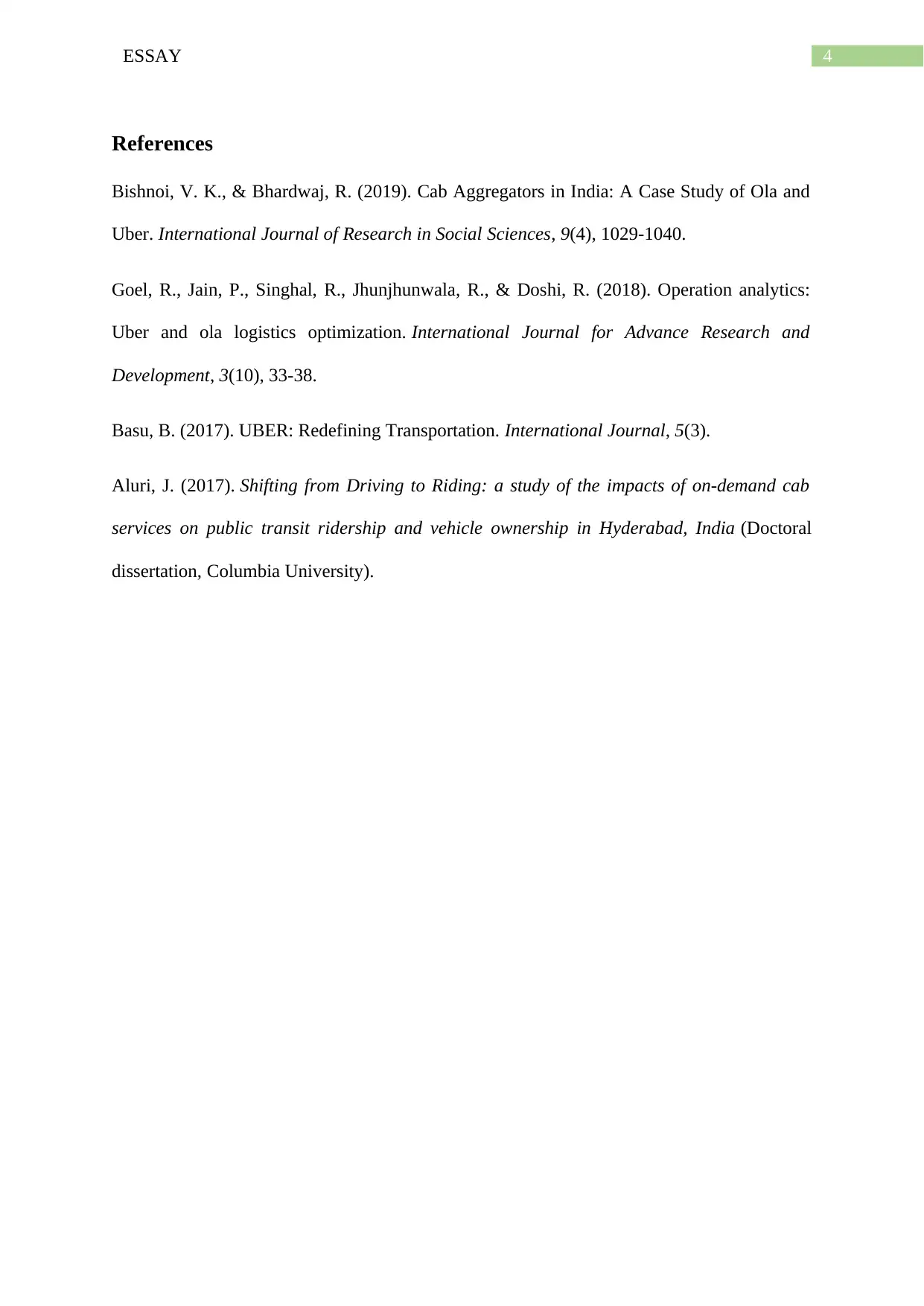MIS500 Foundations of Information Systems: The Next Uber/Taxi Paradigm
VerifiedAdded on 2022/08/20
|5
|1266
|15
Report
AI Summary
This report critically analyzes the next paradigm shift in the taxi industry following the disruption caused by companies like Uber and Ola. It explores the impact of services like Uber Moto and Ola Bikes on private car and bike ownership, arguing that these services offer convenient and cost-effective alternatives, especially in developing countries. The report highlights how the new paradigm, driven by innovative business models and information systems, has affected traditional taxi services and the automotive industry. It concludes that the availability of on-demand, two-wheeled transport options is reshaping consumer behavior and challenging the conventional notion of vehicle ownership. Desklib provides access to similar solved assignments and resources for students.

Running head: ESSAY
Topic 2 - What is the next Uber/Taxi paradigm?
Name of the Student
Name of the University
Author Note
Topic 2 - What is the next Uber/Taxi paradigm?
Name of the Student
Name of the University
Author Note
Paraphrase This Document
Need a fresh take? Get an instant paraphrase of this document with our AI Paraphraser

1ESSAY
Introduction
The public and private transportation services have been highly transformed after the
introduction of Uber, Ola and the other similar vehicle services. They have introduced the
mobile based applications that enables a user to book a personal or shared service of taxi or
likewise vehicles according to their convenience. These also enables the user to make the
vehicle pick them up from the location of their convenience and at the same time drop them
at their desired location. It is evident that the impact of these services is extremely visible on
the public taxi services. The utilization of the public taxis has reduced at an alarming rate all
around the world and the Uber, Ola and other services like these have emerged as the most
utilized ones (Aluri, 2017). However, the services that these organizations provide to the
people have not only been restricted to taxi vehicles but, the organizations have also
developed the schemes of Uber Moto, Ola Bikes and others, that are mostly the two-tyred
vehicles that are used as a customized ride for only one person at a time. The prices for these
rides are much reduced but at the sake for compromising with the comfort of travelling in an
air-conditioned car. However, the impact of the next paradigm of introducing Uber Moto and
Ola Bikes has been extremely impacting upon the private car and bike ownership industries.
These impacts would be critically analysed with the help of this essay as per the evidence-
based discussion as below.
Evidence based discussion and critical analysis
There have been several reports based on the quotes by the Uber CEO Dara Khosrow
Shahi about his idea behind the development of the innovative services. He quoted that he
had used his own likings for the business and he had the vision that the customers would also
prefer the same for their convenience. The introduction of these services has been developed
on his idea of having services available at any point of time rather than owning a car or bike
Introduction
The public and private transportation services have been highly transformed after the
introduction of Uber, Ola and the other similar vehicle services. They have introduced the
mobile based applications that enables a user to book a personal or shared service of taxi or
likewise vehicles according to their convenience. These also enables the user to make the
vehicle pick them up from the location of their convenience and at the same time drop them
at their desired location. It is evident that the impact of these services is extremely visible on
the public taxi services. The utilization of the public taxis has reduced at an alarming rate all
around the world and the Uber, Ola and other services like these have emerged as the most
utilized ones (Aluri, 2017). However, the services that these organizations provide to the
people have not only been restricted to taxi vehicles but, the organizations have also
developed the schemes of Uber Moto, Ola Bikes and others, that are mostly the two-tyred
vehicles that are used as a customized ride for only one person at a time. The prices for these
rides are much reduced but at the sake for compromising with the comfort of travelling in an
air-conditioned car. However, the impact of the next paradigm of introducing Uber Moto and
Ola Bikes has been extremely impacting upon the private car and bike ownership industries.
These impacts would be critically analysed with the help of this essay as per the evidence-
based discussion as below.
Evidence based discussion and critical analysis
There have been several reports based on the quotes by the Uber CEO Dara Khosrow
Shahi about his idea behind the development of the innovative services. He quoted that he
had used his own likings for the business and he had the vision that the customers would also
prefer the same for their convenience. The introduction of these services has been developed
on his idea of having services available at any point of time rather than owning a car or bike

2ESSAY
for themselves. He is of the belief that the idea of owning a car or a bike can result into a trap
which can be prevented (Basu, 2017). There are several developing countries where a car or
bike might not be prevailing as a convenient travel offer for any random public. A person
coming from a humble background might even not be able to book a car service from Uber or
Ola at surge rate at the times of extreme need. The next paradigm of the Uber Motos and Ola
Bikes have been developed keeping in mind about these humble customers.
The convenience and requirement of a two-tyred vehicle is felt at the time of traffic
congestions. At this time, the person coming from a humble background might think about
owning a bike for themselves, when they either cannot avail a car service from Ola or Uber;
or even cannot avail public transport because of the timing constraints. Therefore, this
paradigm comes into the rescue of these customers by making the availability of the Uber
Motos and Ola Bikes (Goel et al., 2018). They do not just offer convenience of time but also
come at such cheap travel rates that they can be considered as the rates for general public
vehicles. The idea about the convenient bike rides is a paradigm that is still not at all a fully
functional activity over the developing countries but it is considered that if the new paradigm
works out, the CEO would be planning on increasing the head counts after getting a report on
the impact on the people by the Research and Development or R&D team.
However, even in its initial stages, the paradigm has heavily impacted upon the
private car and bike ownership industries. Uber has already won a battle against the mobility
services across 210 DMRC stations in developing countries as the private car and bike
ownership industries were already threatened by the inclusions (Bishnoi & Bhardwaj, 2019).
However, it is a natural fact that owning a private car or bike results to more cash outflow
than having an Ola or Uber ride on bikes. Therefore, the people would be less likely to buy a
new bike or even a car, owing to this new paradigm.
for themselves. He is of the belief that the idea of owning a car or a bike can result into a trap
which can be prevented (Basu, 2017). There are several developing countries where a car or
bike might not be prevailing as a convenient travel offer for any random public. A person
coming from a humble background might even not be able to book a car service from Uber or
Ola at surge rate at the times of extreme need. The next paradigm of the Uber Motos and Ola
Bikes have been developed keeping in mind about these humble customers.
The convenience and requirement of a two-tyred vehicle is felt at the time of traffic
congestions. At this time, the person coming from a humble background might think about
owning a bike for themselves, when they either cannot avail a car service from Ola or Uber;
or even cannot avail public transport because of the timing constraints. Therefore, this
paradigm comes into the rescue of these customers by making the availability of the Uber
Motos and Ola Bikes (Goel et al., 2018). They do not just offer convenience of time but also
come at such cheap travel rates that they can be considered as the rates for general public
vehicles. The idea about the convenient bike rides is a paradigm that is still not at all a fully
functional activity over the developing countries but it is considered that if the new paradigm
works out, the CEO would be planning on increasing the head counts after getting a report on
the impact on the people by the Research and Development or R&D team.
However, even in its initial stages, the paradigm has heavily impacted upon the
private car and bike ownership industries. Uber has already won a battle against the mobility
services across 210 DMRC stations in developing countries as the private car and bike
ownership industries were already threatened by the inclusions (Bishnoi & Bhardwaj, 2019).
However, it is a natural fact that owning a private car or bike results to more cash outflow
than having an Ola or Uber ride on bikes. Therefore, the people would be less likely to buy a
new bike or even a car, owing to this new paradigm.
⊘ This is a preview!⊘
Do you want full access?
Subscribe today to unlock all pages.

Trusted by 1+ million students worldwide

3ESSAY
Knowledge and understanding of key concepts
The primary concept that is being looked into for this is the term “paradigm”. This, as
the literal word suggests, is a pattern or a model. However, in terms of business, the term
business paradigm means a new business model that would make sure how the company
stands or emerges in the market with their new implemented idea. The key concept about the
new paradigm of Uber and Ola about introducing bike services called Uber Moto and Ola
Bikes have also impacted upon the private car and bike ownership industries, which is the
primary concept of this essay.
Conclusion
Therefore, in conclusion, it can be said that after the impact on the public taxi industry
by Uber and Ola, the organizations have also impacted upon the private car and bike
ownership industries. This is because of the new paradigm of introduction for the Uber Motos
and Ola Bikes have also made the customers avail bike services customized for one person at
a time during the time of dire necessity. These services do not only offer the users and the
customers to have their personalized bikes at the ready for travelling convenience at the times
of time crunches but are also available at the rates of public transports. Naturally, there would
be heavy impacts on the private car and bike ownership industries as having an owned bike or
car proves to be much less cost effective than having an Uber Moto or Ola Bike ride.
Therefore, it is not just the public taxi industry that is affected by the Uber and Ola taxi
services, but also the private car and bike ownership industries that are affected by the new
paradigm of Uber Moto and Ola Bikes.
Knowledge and understanding of key concepts
The primary concept that is being looked into for this is the term “paradigm”. This, as
the literal word suggests, is a pattern or a model. However, in terms of business, the term
business paradigm means a new business model that would make sure how the company
stands or emerges in the market with their new implemented idea. The key concept about the
new paradigm of Uber and Ola about introducing bike services called Uber Moto and Ola
Bikes have also impacted upon the private car and bike ownership industries, which is the
primary concept of this essay.
Conclusion
Therefore, in conclusion, it can be said that after the impact on the public taxi industry
by Uber and Ola, the organizations have also impacted upon the private car and bike
ownership industries. This is because of the new paradigm of introduction for the Uber Motos
and Ola Bikes have also made the customers avail bike services customized for one person at
a time during the time of dire necessity. These services do not only offer the users and the
customers to have their personalized bikes at the ready for travelling convenience at the times
of time crunches but are also available at the rates of public transports. Naturally, there would
be heavy impacts on the private car and bike ownership industries as having an owned bike or
car proves to be much less cost effective than having an Uber Moto or Ola Bike ride.
Therefore, it is not just the public taxi industry that is affected by the Uber and Ola taxi
services, but also the private car and bike ownership industries that are affected by the new
paradigm of Uber Moto and Ola Bikes.
Paraphrase This Document
Need a fresh take? Get an instant paraphrase of this document with our AI Paraphraser

4ESSAY
References
Bishnoi, V. K., & Bhardwaj, R. (2019). Cab Aggregators in India: A Case Study of Ola and
Uber. International Journal of Research in Social Sciences, 9(4), 1029-1040.
Goel, R., Jain, P., Singhal, R., Jhunjhunwala, R., & Doshi, R. (2018). Operation analytics:
Uber and ola logistics optimization. International Journal for Advance Research and
Development, 3(10), 33-38.
Basu, B. (2017). UBER: Redefining Transportation. International Journal, 5(3).
Aluri, J. (2017). Shifting from Driving to Riding: a study of the impacts of on-demand cab
services on public transit ridership and vehicle ownership in Hyderabad, India (Doctoral
dissertation, Columbia University).
References
Bishnoi, V. K., & Bhardwaj, R. (2019). Cab Aggregators in India: A Case Study of Ola and
Uber. International Journal of Research in Social Sciences, 9(4), 1029-1040.
Goel, R., Jain, P., Singhal, R., Jhunjhunwala, R., & Doshi, R. (2018). Operation analytics:
Uber and ola logistics optimization. International Journal for Advance Research and
Development, 3(10), 33-38.
Basu, B. (2017). UBER: Redefining Transportation. International Journal, 5(3).
Aluri, J. (2017). Shifting from Driving to Riding: a study of the impacts of on-demand cab
services on public transit ridership and vehicle ownership in Hyderabad, India (Doctoral
dissertation, Columbia University).
1 out of 5
Related Documents
Your All-in-One AI-Powered Toolkit for Academic Success.
+13062052269
info@desklib.com
Available 24*7 on WhatsApp / Email
![[object Object]](/_next/static/media/star-bottom.7253800d.svg)
Unlock your academic potential
Copyright © 2020–2025 A2Z Services. All Rights Reserved. Developed and managed by ZUCOL.





